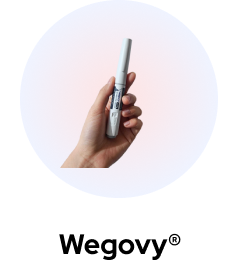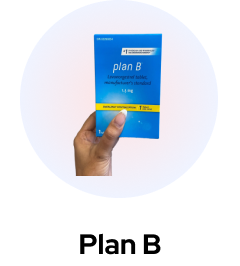As Ozempic grows in popularity, more and more people are looking for information about this drug and whether or not they should start it. But how exactly can you get on Ozempic?
In this article, we’ll cover:
- What Ozempic is and how it works
- Our guide to getting an Ozempic prescription
- How to finance your Ozempic prescription
- Guidelines and precautions you should be aware of
- Frequently asked questions.
Ready to dive in and learn more? Read on!
Ozempic is a medication that was developed by the pharmaceutical company Novo Nordisk in 2012 (who also hold the rights for all semaglutide-based medications). Ozempic is primarily prescribed to patients suffering from type 2 diabetes, but is also approved for use in those with a BMI of 27 or higher.
Health Canada has approved Ozempic for use in adults only and not in children. It is not intended for use by those with type-1 diabetes.
The active ingredient in Ozempic is a drug called semaglutide, which is able to target a variety of pathways which can provide a range of benefits when it comes to combating the symptoms of type-2 diabetes, as well as be used as an effective tool for assisting with weight management.
You may also see semaglutide marketed under other brand names, such as Wegovy or Rybelsus.
Studies have shown that Ozempic can aid in maintaining healthy blood sugar levels, increasing insulin production, and improving cardiovascular health, as well as assisting with weight management. It’s most effective when combined with a healthy diet and regular exercise.
How Ozempic Works
Ozempic utilizes the active ingredient semaglutide and the many benefits that it can provide due to its role as a glucagon-like peptide-1 (GLP-1) receptor agonist.
The GLP-1 hormone is what is naturally released in your gut after eating. This hormone stimulates insulin production, balances your blood glucose levels, and helps you feel full and satisfied after eating, along with a range of other benefits.
Semaglutide is able to mimic the GLP-1 hormone and provide these same benefits at an increased rate. This means it can help with improved blood glucose control, increased insulin production, a decreased appetite, and better satiety after eating.
Uses of Ozempic: What Conditions Does it Treat?
Ozempic is used to treat type-2 diabetes as well as assist with weight management in those with a BMI of 27 or higher.
Ozempic is also known to be highly effective at reducing the risk of major cardiovascular events. This includes lowering triglycerides and cholesterol, reducing high blood pressure, the risk of stroke, heart disease, heart attack, and death.
However, lifestyle intervention is also necessary to achieve the best results on this drug, including implementing a healthy diet (with low-fat and low-sugar foods, as well as smaller portion sizes), as well as regular exercise and activity.
In those with obesity, you may also want to consider therapy to address your underlying relationship with food. The weight management process is often just as much psychological as physical. Understanding why you overeat goes a long way to helping your overall relationship with what you consume, and yourself.
As with all medications, there are a number of side effects you should be aware of when taking Ozempic. While some are common and less serious, others (though rarer) are more serious.
Additionally, some people and medications are contraindicated for Ozempic and semaglutide. If you:
- Have a personal or family history of medullary thyroid carcinoma (MTC)
- Have a personal or family history of multiple endocrine neoplasia type 2 (MEN 2)
- Are pregnant, breastfeeding, or intending to conceive in the next two months do not take Ozempic.
Additionally, you should be sure to discuss any and all prescription medications (including supplements and vitamins) you’re currently taking with your medical team before starting this drug.
Common side effects include:
- Nausea
- Vomiting
- Abdominal pain
- Constipation
- Diarrhea
- Dizziness
- Fatigue
- Gas.
Other more serious side effects include:
- Hypoglycemia
- Risk of thyroid cancer
- Gallbladder issues
- Kidney problems
- Pancreatitis (inflammation of the pancreas)
- Vision issues (diabetic retinopathy)
- Allergic reactions.
If you experience any of the above more serious side effects, discontinue your use of the drug immediately and contact your medical team, or go directly to your local ER.
Exploring Ozempic’s Role in Weight Loss
There are several factors that contribute to Ozempic’s ability to aid in weight loss and body weight management. By utilizing the GLP-1 receptor agonist semaglutide, Ozempic is able to recreate many of the effects of the GLP-1 hormone.
Several of these effects are useful when it comes to weight loss, such as:
- Reduced hunger and appetite
This is one of the effects of Ozempic that is said to be the most immediately noticeable. By mimicking the reduction in appetite that the GLP-1 hormone provides, Ozempic is able to cut down feelings of hunger even further.
Often, this can lead to changes in a person’s diet and eliminate mindless snacking and emotional eating, which contribute heavily to weight gain.
- Delayed gastric emptying
Ozempic has been known to cause a delay in gastric emptying. Delayed gastric emptying reduces the rate at which glucose appears in circulations and causes food to linger for longer in your stomach.
For those needing to manage their weight, this can be a great help and put you into a caloric deficit.
- Increased satiety
After you eat, it is important that you feel full and satisfied in order to combat overeating. Ozempic is able to activate pathways that increase your feeling of satiety after eating. This can help you to stick to diet plans without feeling hungry and avoid overeating.
While Ozempic won’t burn all of your body fat as soon as it gets into your system, it has several practical benefits that may assist with changing your lifestyle, and can be beneficial for everyone on the drug.
When paired with exercise and a balanced diet, Ozempic can be an incredibly helpful aid in your weight management journey.
There have been many clinical trials and a great deal of research conducted on the effectiveness of Ozempic. This research focuses on a range of different benefits of Ozempic, such as weight management effectiveness, blood glucose control, and the effect on cardiovascular health.
In a two-year trial that focused on semaglutide’s weight management effectiveness (the active ingredient in Ozempic), it was found that significant body mass loss was achieved, with a loss of 20% being observed at week 104.
In terms of blood sugar control, a 2021 study showed that Ozempic was able to assist with insulin resistance and reduce blood sugar levels consistently over a period of 40 weeks.
As for cardiovascular health, the SUSTAIN 6 trial indicated that Ozempic is able to significantly reduce major cardiovascular incidents, and it has since become one of the approved drugs to aid with cardiovascular health.
How to Get an Ozempic Prescription: A Step-by-Step Guide
Ozempic is a prescription-only medication, so you are required to have a prescription in order to acquire it. Only those with pre-approved conditions are able to be prescribed Ozempic, and you’ll need to discuss this with your medical team.
Securing an Ozempic Prescription from Your Doctor
The first step in getting on Ozempic is making an appointment with your medical team for evaluation. From here, it will be determined whether or not Ozempic is a suitable medication for you to start taking.
If you have type-2 diabetes, you may be eligible for Ozempic, as long as you have no other underlying health conditions or are on any other medications that prevent this.
Bear in mind that in some cases you will only be able to be prescribed Ozempic if you have satisfied various conditions, including a trial of other drugs for the treatment of type-2 diabetes for a period of time (such as metformin), or if you are contraindicated for other treatment.
If you want to use Ozempic for assistance with weight management, you will only be prescribed the drug if you have a BMI of 27 or higher. In some cases, you may also need to satisfy other criteria, including having one or more weight-related conditions as a result of your high BMI.
Always follow your medical team’s advice closely, and do not attempt to take Ozempic if it has been determined that it is not suitable for you. Not only is it illegal to take Ozempic without a prescription, it could also be potentially harmful to your health.
Navigating the Online Route: Can You Buy Ozempic Online?
If you end up being prescribed Ozempic and want to buy your dose online, the good news is there are some online pharmacies that offer Ozempic.
By purchasing your Ozempic online, there are also often special discounted rates available. Just be sure that you are buying from a reputable online pharmacy. Check that your online pharmacy of choice is licensed and has a valid physical address listed on their website.
You should also note that sales in B.C. are restricted to Canadian residents only, thanks to a surge of popularity in the drug, and fears that U.S. patients would attempt to purchase the medication overseas (where it’s much cheaper).
Filling Out Your Ozempic Prescription at a Retail Pharmacy
You can, of course, pick up your Ozempic prescription at a physical retail pharmacy. Prices differ depending on the particular pharmacy, so often patients will check a range of different pharmacies for the best deal.
It is also a good idea to call ahead and check that your chosen pharmacy provides Ozempic.
Utilizing a Mail Order Pharmacy for Ozempic
Many mail-order pharmacies will offer Ozempic so that you are able to get your prescription without leaving your home — and potentially at a discounted rate.
Be sure to check that the mail-order pharmacy you choose is valid and licensed.
Financing Your Ozempic: Costs and Savings
Medication isn’t always cheap, and it is a good idea to check just how much your Ozempic prescription is going to cost you and make sure that it is within your budget.
The cost of Ozempic can differ depending on a range of different factors, such as whether you have insurance or not, which pharmacy you buy from, and how much Ozempic you are needing.
Understanding Ozempic’s Cost: With and Without Insurance
Depending on your circumstances, Ozempic may be covered by your insurance. If you have been prescribed Ozempic to treat type-2 diabetes, it is likely that your insurance coverage will include the cost of the drug in full, though this depends on your plan and region.
If you’ve been prescribed Ozempic for weight management, you may still be covered though it’s unlikely to include the full amount. Be aware that, depending on your insurer, you may have to pay some or all of the cost of your medication out of pocket.
While the cost of Ozempic in Canada is significantly lower than the U.S. list price, it’s still several hundred dollars, which may affect your access to the drug. Again, this is entirely dependent on the pharmacy you go to, and how much of this cost is covered by your health insurance — if not all of it.
Comparing Ozempic Prices Between Pharmacies
Once you have your Ozempic prescription, it is a good idea to shop around and check which pharmacy is offering the best price. Whether this is an online pharmacy or a physical one, there will likely be a significant difference in the price of Ozempic depending on which pharmacy you choose.
When it comes to online pharmacies, you can often check the price of Ozempic on their website, and flick through a few different pages in order to find the best price.
As for physical pharmacies, you can either call or visit instore to inquire about the price of Ozempic.
Enrolling in Ozempic Co-Pay Assistance Programs
There are some co-pay assistance programs that will be able to help you find the best deal when buying your Ozempic. There are online services in which you can look up your co-pay and see how much Ozempic will cost for you.
Are You Eligible for an Ozempic Savings Card?
Unfortunately, Ozempic Savings Cards are only available to U.S. residents.
Considering a Lower Dosage or Alternative Treatment to Save Costs
There is a chance that your Ozempic prescription will simply be out of your budget. If this is the case, consult with your medical team and look into switching to either a lower dosage of Ozempic or to an entirely different medication or treatment plan.
There are several other options out there when it comes to treating type-2 diabetes or for assistance with weight management that may be more suitable for you and your financial situation.
Taking Ozempic: Guidelines and Precautions
If you are starting Ozempic, it is important to know all the details of this medication and the guidelines that you’ll need to follow when taking it.
Knowing the correct dosage of Ozempic and how to accurately administer it is critical as it will ensure that the medication is going to be effective and you won’t face any adverse reactions.
Unveiling Ozempic’s Dosing: What You Need to Know
The dosage of Ozempic that you are prescribed will differ depending on your condition, the severity, and your medical history.
When initially starting Ozempic, it is likely that you will start off on a lower dose which will be increased to a maintenance dose around week four.
As it stands, the initial dose of Ozempic is generally a weekly injection of around 0.25 mg for four weeks. This will likely be followed by a weekly injection of 0.5mg.
After this dosage level has been reached, the way you respond to Ozempic will be carefully monitored, and your medical team may increase your dosage further.
If further blood sugar management is required, your dosage will either be increased to 1 mg or 2 mg (the maximum dose).
Detailed Instructions: How to Take Ozempic Properly
Your medical team or pharmacist should be able to demonstrate how to use Ozempic before your first time using the drug.
However, if you’re a little confused or need a refresher, here is how to administer Ozempic:
- Check your pen
Ozempic comes in the form of a pen that is used to administer a subcutaneous injection. Double check the label and the medicine in your pen. The contents of the vial inside the pen should be colorless.
- Attach a fresh needle
Tear off the paper tab on the Ozempic Pen and push and twist on the new needle until it is tight. Remove both needle caps.
- Check the flow
Twist the dose selector on the pen until the dose counter is displaying the flow check symbol. Press and hold the dose button until the counter turns to 0. Ensure that a drop appears at the tip of the needle.
- Select the correct dose
Turn the dose selector until the dose counter is displaying the dose that you have been prescribed.
- Inject
Insert the needle into the skin of your abdomen, thigh, or upper arm. The location of your injection site should be rotated every week. Press and hold the dose button until the counter reaches 0, then count slowly to 6. Remove the needle from your skin.
- Cleanup
Carefully remove the used needle from your Ozempic Pen and dispose of it safely in a needle or sharps container. Replace the cap back on the pen.
If you have any questions regarding use of the Ozempic Pen, consult the Ozempic Medication Guide and Instructions for Use or speak with your medical team.
Be sure to never share your Ozempic Pen with anyone, even with a fresh needle.
Key Takeaways
If you want to get on Ozempic, there are a few important factors to consider. Since it’s a prescription-only medication, you will need to consult your medical team and meet the criteria required in order to qualify.
There is also the matter of cost, including whether Ozempic is covered by your insurance and which pharmacy is best to buy your Ozempic from.
If you are struggling to cover the cost of your Ozempic, there are resources that may be able to help. Failing that, your medical team may be able to recommend other treatment options.
Frequently Asked Questions
What should I do if I miss a dose of Ozempic?
If you miss an Ozempic dose, take the missed dose as soon as you remember, as long as it’s within five days of when the dose was meant to be taken.
If it has been longer than five days, simply skip the missed dose and continue with your next dose as normal.
Are there any side effects of Ozempic?
As is the case with most medications, there are some side effects to expect when starting Ozempic.
If you believe you are experiencing particularly severe or concerning side effects, consult your medical team for advice.
Some common side effects of Ozempic include:
- Nausea
- Vomiting
- Abdominal pain
- Constipation
- Diarrhea
- Dizziness
- Fatigue
- Gas.
These side effects tend to be the most severe when first starting the medication or adjusting to an increased dosage, but may persist.
Never hesitate to reach out to your medical team if you believe that you are experiencing side effects that are extremely severe, long lasting, or unusual.













 (US)
(US)